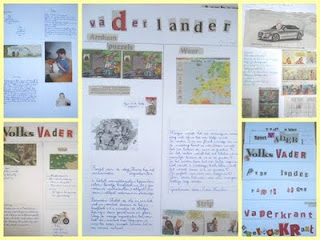Made by a student of grade 6
You need:- bandage plaster
- vaseline
- towel
- jar with water
- scissors
- canvas
- cloth tape
- tempera paint
- brush
- stuff to decorate, like feathers, stones, shells, ribbons
- glue
1. Put a towel around the shoulders and pull the hair off the face.
2. Coat the face well with vaseline, especially hair line, eyebrows and eyelashes.
3. Cut the bandage plaster in strips. Make the strips one by one wet and cover the face. Be sure the strips overlap a little. Leave the nose open.
4. Provide three layers plaster for a solid mask.
5. Remove the mask after 15 minutes.
6. Close the hole of the nose with a last plaster strip.
Outline the mask with a pencil on a canvas. Cut a hole in the canvas about 1 centimeter smaller than the mask. Push the mask through the hole from the back of the canvas and stick it to the front and back with cloth tape.
Paint the canvas and face with tempera. Decorate the artwork with feathers, ribbons, shells or strass stones.

















